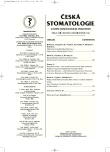Distraction Exercise – a New Method for Conservative Treatment of Anterior Dislocation of Temporomandibular Joint Disc
Authors:
J. Zemen
Authors‘ workplace:
Soukromá zubní ordinace, Plzeň
vedoucí doc. MUDr. J. Zemen, Ph. D.
; Stomatologická klinika LF UK a FN, Plzeň
přednosta doc. MUDr. A. Zicha, CSc.
Published in:
Česká stomatologie / Praktické zubní lékařství, ročník 106, 2006, 6, s. 168-172
Overview
Derangements of the temporomandibular condyle-disc complex are divided into two categories:
disc dislocation with reduction and disc dislocation without reduction. Definitive treatment for a disc dislocation is to reestablish a normal condyle-disc relationship. Although this may sound relatively easy, it has not proven to be so. There is used the anterior repositioning appliance, muscle relaxation appliance or supportive therapy as the analgesic or non-steroidal antiflogistic drugs and distractive manual manipulation. Another relatively conservative surgical approach for treating these intracapsular disorders is arthrocentesis or arthroscopy. When indicated, the joint may need to be opened for reparative surgery procedures.
The author describes in this article his original temporomandibular joint distraction exercise. This exercise is suitable for derangements of the temporomandibular condyle-disc complex. In common practice is this exercise called as the „Zemen’s wooden kitchen spoon exercise” according to the instrument used during exercise. On principle the instrument (e.g. hand grip of the wooden kitchen spoon or of the wooden twirling-stick) is applied between the molars of the upper and lower jaw as the center of two-armed lever, the repeated nods against the resistance of the hand follow in three short series. The effect of the exercise is the dilatation of the joint space and facilitation of the disc reposition. The exercise must be repeated several times a day, sometimes for weeks. The author has more than 3 years experience with this non-invasive exercise treatment method of temporomandibular disc dislocation. The exercise is effective especially in disc dislocation without reduction.
Key words:
temporomandibular disorders – disc dislocation with reduction – disc dislocation without reduction – original distraction exercise – Zemen’s wooden kitchen spoon exercise
Labels
Maxillofacial surgery Orthodontics Dental medicineArticle was published in
Czech Dental Journal

2006 Issue 6
Most read in this issue
- Inflammatory Myofibroblastic Tumor
- Distraction Exercise – a New Method for Conservative Treatment of Anterior Dislocation of Temporomandibular Joint Disc
- Our Contribution to Semipermanent Splinting
- Late Orthodontic Prosthetic Therapy with the Use of Delair Mask
